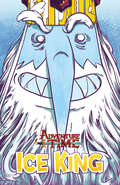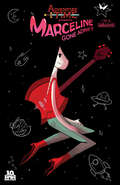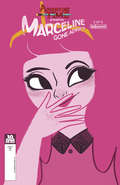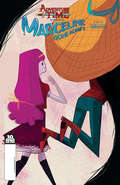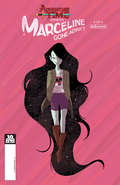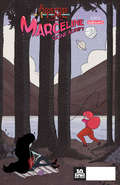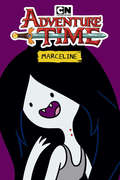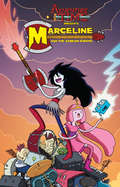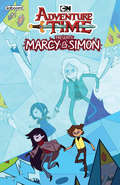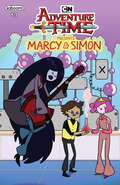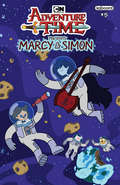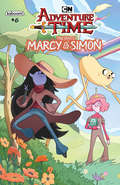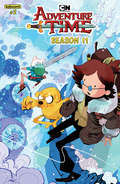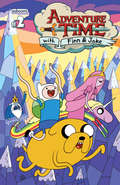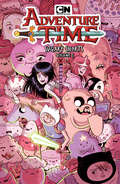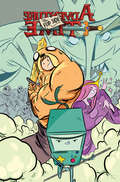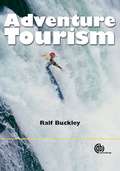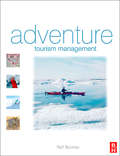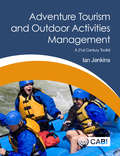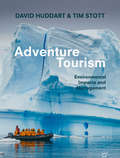- Table View
- List View
Adventure Time: Ice King (Adventure Time: Ice King #1)
by Natalie Andrewson Prana Naujokaitis Emily PartridgeIce King might be the pro when it comes to kidnapping princesses but he finds himself on the other side of things when he wakes up to find his faithful companion, Gunther the penguin, has been taken! It's a high flying adventure as Ice King looks for help in the wackiest of places, tries to be cool, and learns something new about himself along the way. Adventure Time storyboard artist Emily Partridge and writer Pranas Naujokaitis (Uncle Grandpa) weave an enchanting tale about friendship and understanding with illustrations by Natalie Andrewson that show the beauty behind ice puns.
Adventure Time: Jake (Adventure Time)
by Pendleton WardIt’s Adventure Time with Jake and you! Join Jake on the most algebraic adventure imaginable with tales all about the best canine pal you could ask for in the Land of Ooo. From teaching everyone how to cook to teaming up with Finn to fight every foe imaginable, Adventure Time: Jake collects all the stories that make the Eisner Award-winning series perfect for fans of all ages. Join an all-star cast of creators, including Christopher Hastings (Adventure Time, Gwenpool), James Asmus (The Amazing Spider-Man), Derek Fridolfs (DC Comics: Secret Hero Society), Nicole Andelfinger (Lumberjanes, Regular Show), and more in this timeless collection of Jake’s greatest Adventure Time stories.
Adventure Time: Marceline Gone Adrift #1 (Marceline Gone Adrift #1)
by Carey Pietsch Meredith Gran<p>Marceline is on a rampage for mysterious reasons, and the kingdom of Ooo is desperately scrambling to stop her. In trying to save both Ooo and Marceline herself, Princess Bubblegum accidentally propels Marceline into the farthest reaches of space and strips her of her powers! Guilt-ridden, Princess Bubblegum sets off on a space rescue that'll test the power of her mind...as well as the power of friendship. <p>This is a fixed-format ebook, which preserves the design and layout of the original print book.</p>
Adventure Time: Marceline Gone Adrift #2 (Marceline Gone Adrift #2)
by Carey Pietsch Meredith Gran<p>Marceline finds herself in a whole new world while Princess Bubblegum realizes her mistake and starts planning how to bring her friend back. The threat to Ooo might be down for now, but one unlikely bun is going to suddenly find himself with too much power to handle! <p>This is a fixed-format ebook, which preserves the design and layout of the original print book.</p>
Adventure Time: Marceline Gone Adrift #3 (of 6) (Marceline Gone Adrift #3)
by Carey Pietsch Meredith Gran<p>Princess Bubblegum might have finally found a way to get Marceline, but that doesn't mean things are going to get any easier for her. Marceline might be stuck with her new friends on this strange planet, but that doesn't mean she's got to like them...or be nice to them and what is up with this place anyway?! <p>This is a fixed-format ebook, which preserves the design and layout of the original print book.</p>
Adventure Time: Marceline Gone Adrift #4 (of 6) (Marceline Gone Adrift #4)
by Carey Pietsch Meredith Gran<p>Marceline and Princess Bubblegum are gonna have to work together if they want to get off that weird planet and back to Ooo before Cinnamon Bun destroys it with his crazy power. <p>This is a fixed-format ebook, which preserves the design and layout of the original print book.</p>
Adventure Time: Marceline Gone Adrift #5 (of 6) (Marceline Gone Adrift #1 - 6)
by Carey Pietsch Meredith Gran<p>Marceline is on a rampage for mysterious reasons, and the kingdom of Ooo is desperately scrambling to stop her. In trying to save both Ooo and Marceline herself, Princess Bubblegum accidentally propels Marceline into the farthest reaches of space and strips her of her powers! Guilt-ridden, Princess Bubblegum sets off on a space rescue that'll test the power of her mind...as well as the power of friendship. Collects the complete six-issue limited series. <p>This is a fixed-format ebook, which preserves the design and layout of the original print book.</p>
Adventure Time: Marceline Gone Adrift #5 (of 6) (Marceline Gone Adrift #5)
by Carey Pietsch Meredith Gran<p>As Marceline and Princess Bubblegum try to get back to Ooo, Finn has to figure out how to deal with the Suspencer when he can't get close to him! Meanwhile, Cinnamon Bun is taking advantage of his new abilities to the extreme. <p>This is a fixed-format ebook, which preserves the design and layout of the original print book.</p>
Adventure Time: Marceline Gone Adrift #6 (of 6) (Marceline Gone Adrift #6)
by Carey Pietsch Meredith Gran<p>Final issue! Marceline and Princess Bubblegum are back and ready to take care of business in Ooo. It'll take the power of science and friendship to stop Cinnamon Bun and Suspencer. <p>This is a fixed-format ebook, which preserves the design and layout of the original print book.</p>
Adventure Time: Marceline The Pirate Queen (Adventure Time #6)
by Pendleton WardIt’s Adventure Time with Marceline and you! Join Marceline the Vampire Queen on a rocking tour throughout all her best adventures in the Land of Ooo. From going with Princess Bubblegum on a band tour with the Scream Queens, to derby racing across the Ice Kingdom, to banding together with Finn and Jake to fight her monstrous dad Hunson Abadeer, Adventure Time™: Marceline collects all the stories that make the Eisner Award-winning series perfect for fans of all ages. Join an all-star cast of creators, including Faith Erin Hicks (Buffy: The High School Years), Hanna K (Adventure Time™ Storyboarder), S.M. Vidaurri (Steven Universe™: Harmony), Aatmaja Pandya (Elements: Fire), Jorge Monlongo (Over the Garden Wall™: Hollow Town), and more in this timeless collection of Marceline’s greatest Adventure Time™ stories.
Adventure Time: Marceline and the Scream Queens (Klaus #1)
by Meredith Gran<p>Thanks to a newfound interest in music, Princess Bubblegum joins Marceline's paranormal rock band for a tour across the land of Ooo! But when they're threatened by everything from scenesters to beasts born of self-doubt, can they make it to the RADDEST GIG EVER in time?! <p>This is a fixed-format ebook, which preserves the design and layout of the original print book.</p>
Adventure Time: Marcy & Simon #1 (Adventure Time: Marcy & Simon #1)
by Sj Miller Olivia Olson Slimm FabertAfter the events of the Adventure Time series finale, Marceline and Simon have finally reunited! Now together, Simon asks Marceline for help in making amends for his time as Ice King, which leads them, Finn, and Jake to one of the most dangerous places yet...the Nightosphere! Written by Olivia Olson (Marceline on Adventure Time) and illustrated by Slimm Fabert (Adventure Time) is the perfect story for any fan of the Vampire Queen or the former Ice King!
Adventure Time: Marcy & Simon #3 (Adventure Time: Marcy & Simon #3)
by Olivia OlsonTo save Simon, Marceline, Finn, Jake, and Princess Bubblegum will have to go to lengths none of them thought were possible.
Adventure Time: Marcy & Simon #5 (Adventure Time: Marcy & Simon #5)
by Olicia OlsonMarceline, Simon, Finn, and Jake are on a quest through the multiverse to free Betty from Golb’s control and resolve Simon’s greatest guilt. They’ll have to fight through lots of obstacles—including some aliens—before they eventually find Betty.
Adventure Time: Marcy & Simon #6 (Adventure Time: Marcy & Simon #6)
by Olivia OlsonMarcy and Simon’s quest to find Simon’s lost love has taken them all through the multiverse, but the terrible truth might be more than even they can handle!
Adventure Time: Season 11 (Adventure Time Season 11 #2)
by Ted Anderson Marina Julia Meg Casey Sonny LiewFinn, Jake and their new friend continue on their scavenger hunt around Ooo, marvelling at the changes around them in the wake of the War. The Emmy Award-winning series continues with a new season exclusively in comic book form!
Adventure Time: Sugary Shorts Mathematical Edition (Planet of the Apes #2)
by Pendleton Ward<p>It's Totally Mathematical! Join Finn, Jake, and all of their friends in this second issue of the ongoing comic book series showcasing all-new adventures through the magical Land of Ooo. The boys have embarked on another crazy-cool adventure, and this one will be their longest, most exciting yet! The top-rated Cartoon Network show now has its own comic book! The Adventure is just beginning, so don't miss out on this exploding phenomenon - this is an issue that will go fast! <p>This is a fixed-format ebook, which preserves the design and layout of the original print book.</p>
Adventure Time: Sugary Shorts Vol. 5 (Adventure Time Sugary Shorts #5)
by Pendleton Ward Jeremy Sorese Meredith McClaren Hanna KWith brand-new, never-before-collected stories by fan-favorite Adventure Time comic book creators, Sugary Shorts packs a sweet punch of stories for everyone! From spooky tales with Marceline, to fun shenanigans with BMO, Gunter, and LSP, this selection sweet jams will satisfy all your Candy Kingdom cravings. Including stories from Meredith McClaren (Jem and the Holograms), Jeremy Sorese (Steven Universe), and Hanna K (Adventure Time animator), this volume of Sugary Shorts defies dentistry and proves you can’t have too much of a sweet thing!
Adventure Time: The Flip Side (Klaus #1 - 6)
by Paul Tobin Wook Jin Clark Colleen Coover<p>Finn is suffering from Quest Deficiency and needs his pals to help him find a righteous quest that will fulfill all his adventuring needs! The back of a questing board might seem like the easiest answer, but our hero is about to find out that the easy way out can create a ton of trouble. It's a race against time as Finn and his merry band of questing cohorts fight to complete this switch-a-roo of a mission before the land of Ooo completely destroys itself. Collects the complete miniseries. <p>This is a fixed-format ebook, which preserves the design and layout of the original print book.</p>
Adventure Tourism
by Colin Beard John Swarbrooke Suzanne Leckie Gill PomfretLooking at the past, present and future of adventure tourism, Adventure Tourism: the new frontier examines the product, the adventure tourist profile, and issues such as supply, geography and sustainability. International case studies are used to illustrate these issues, including: Gorilla watching holidays,Trekking on Mount Everest, Diving holidays, and Outward Bound packages.Analysis of the development and nature of adventure tourism accompanies these studies, ensuring that the title is useful both for undergraduate and postgraduate students of tourism and for professionals involved in managing adventure tourism enterprises.There is also a companion website with additional cases, which can be found at www.bh/com/companions/0750651865.
Adventure Tourism
by Ralf BuckleyAdventure tourism is a new, rapidly growing area at both practical and academic levels. Written at an introductory level, Adventure Tourism provides a basic background and covers commercial adventure tourism products across a range of adventure tourism sectors.
Adventure Tourism Management
by Ralf BuckleyThe academic study of adventure tourism is rapidly increasing in popularity, with research beginning to focus on it heavily. This book is a cohesive and comprehensive look at this multi-million dollar industry sector from a variety of perspectives relevant to the teaching of tourism. Ideal for the undergraduate student taking adventure tourism as a single subject degree, or as part of their tourism management studies, this book documents, analyses and offers insight into the latest research in the area. Includes analysis of products, trends, climate change, risk management and environmental management and many others. The Subsectors section within the book offers an overview of the twenty or more definable sectors within the adventure tourism industry considering their origins and history, latest trends and demographic groups. The author then goes on to look in more detail at: Wildlife Tourism, Marine Tourism, Helitourism, and Boardsports.Each chapter will include seven pedagogical elements:* introduction - what the chapter does and doesn't cover * plain-language review of the chapter topic with minimal referencing - essentially like lecture notes * concluding paragraph to the review section explaining how it leads to the next chapter(s)* review of recent research, condensed into tables where possible * revision notes - a few pages of bullet points summarising the review and research * a sample set of assignment questions, three to six per chapter in some cases* readings on relevant topics, condensed from previous publications.
Adventure Tourism and Outdoor Activities Management: A 21st Century Toolkit
by Ian JenkinsAn essential resource for those wishing to understand the driving factors behind the operation of an adventure tourism company, this textbook offers guidance on how to deliver a profitable and sustainable product. The importance of changing markets, technology and corporate social responsibility, including environmental impacts and climate change, are discussed in the context of managing an adventure tourism firm. To remain profitable, companies must address these issues along with the important aspects of risk and safety. Key features include: - Case studies from successful professionals in the industry. - Consideration of the development of sustainable adventure tourism. - Guidance on managing products and customers. Compiled from the author's experience in delivering adventure tourism courses over the last 20 years, this long-awaited book is aimed at both students taking university courses on adventure tourism and outdoor recreation as well as professionals working within the industry.
Adventure Tourism and Outdoor Activities Management: A 21st Century Toolkit
by Ian JenkinsAn essential resource for those wishing to understand the driving factors behind the operation of an adventure tourism company, this textbook offers guidance on how to deliver a profitable and sustainable product. The importance of changing markets, technology and corporate social responsibility, including environmental impacts and climate change, are discussed in the context of managing an adventure tourism firm. To remain profitable, companies must address these issues along with the important aspects of risk and safety. Key features include: - Case studies from successful professionals in the industry. - Consideration of the development of sustainable adventure tourism. - Guidance on managing products and customers. Compiled from the author's experience in delivering adventure tourism courses over the last 20 years, this long-awaited book is aimed at both students taking university courses on adventure tourism and outdoor recreation as well as professionals working within the industry.
Adventure Tourism: Environmental Impacts and Management
by Tim Stott David HuddartThis textbook presents a comprehensive overview of the environmental impacts of various types of adventure tourism and how these can be best managed. This volume follows on from the authors previous textbook – ‘Outdoor Recreation: Environmental Impacts and Management’ and continues the aim of developing a deeper understanding of how tourist numbers impact the environment and to provide practical solutions to these problems. Combining their own first-hand experience and research with extensive literature review the authors' present several popular adventure tourism destinations from across the globe, including the Arctic, the Himalayas, Africa, Australia and Scotland as case studies. Chapters cover the particular challenges faced by each region: including impacts on animals and birds; the spread of invasive plant species and diseases; trail impacts on vegetation; impacts on geological, historical and archaeological sites and pollution and waste issues. A discussion and evaluation of the possible management actions for minimising these impacts and how outdoor recreation tourists can be regulated concludes each chapter. This practical and engaging textbook will be invaluable to students and scholars of adventure tourism and outdoor recreation as well as practitioners and managers working in the field.
